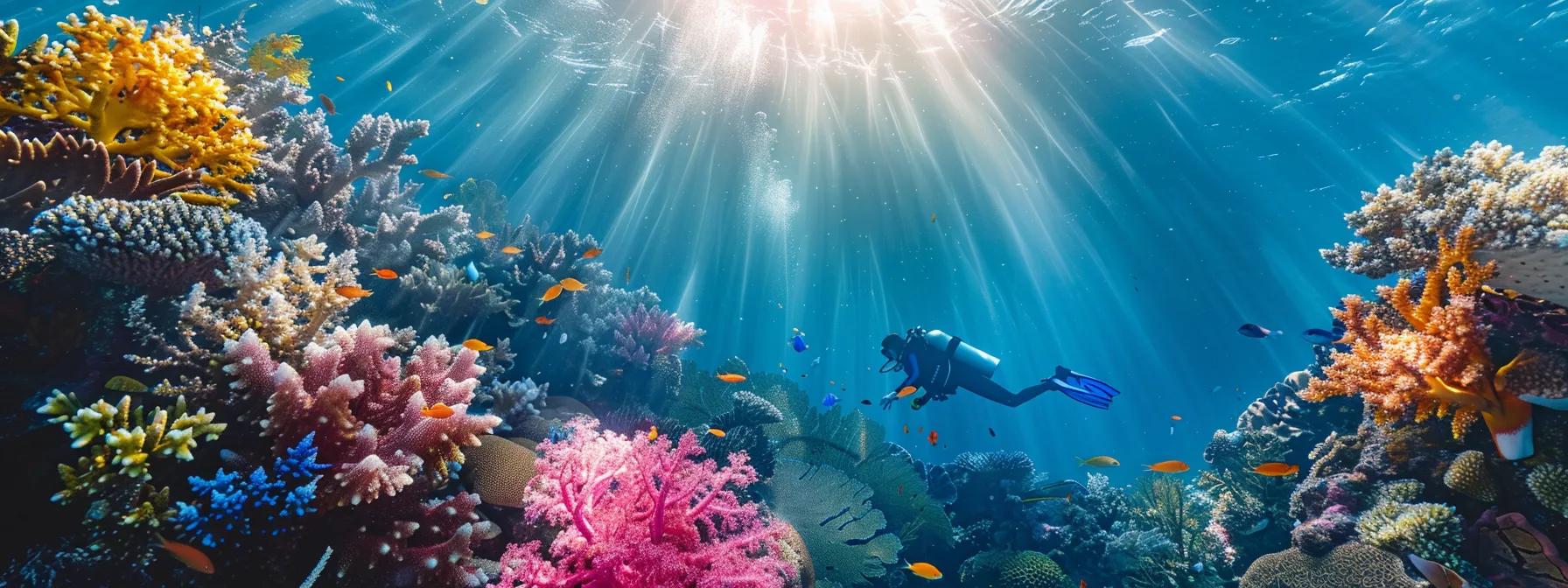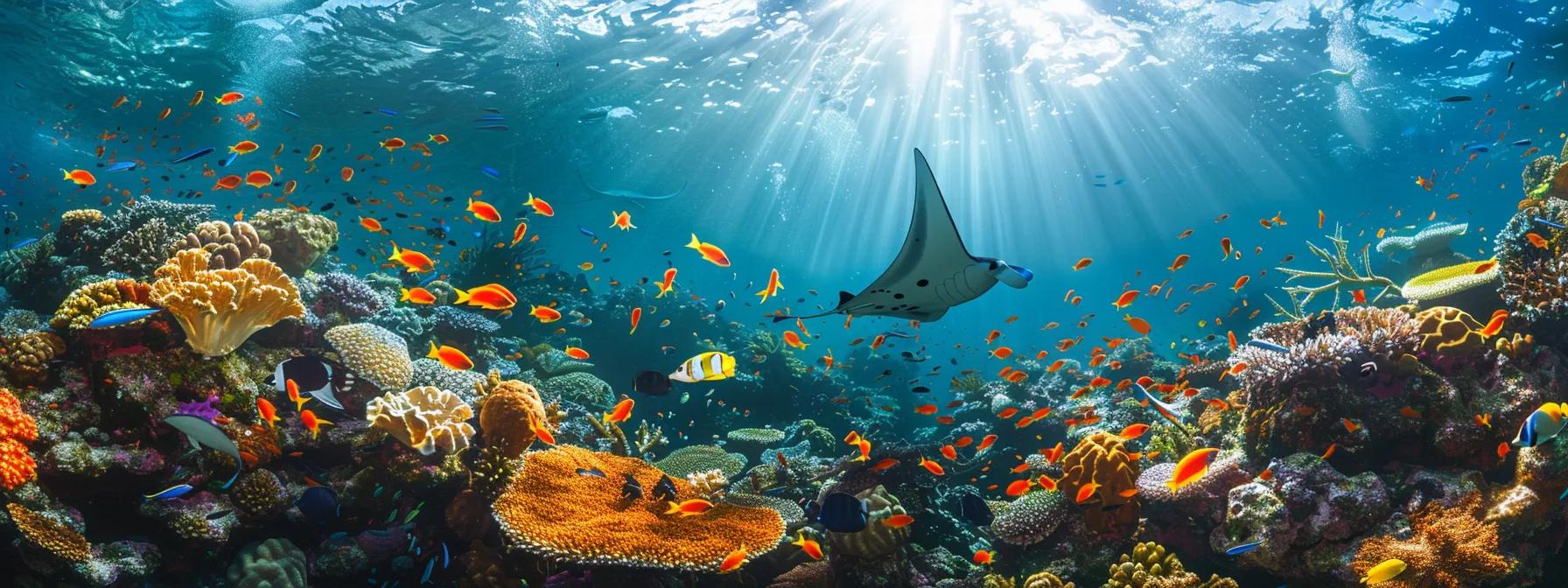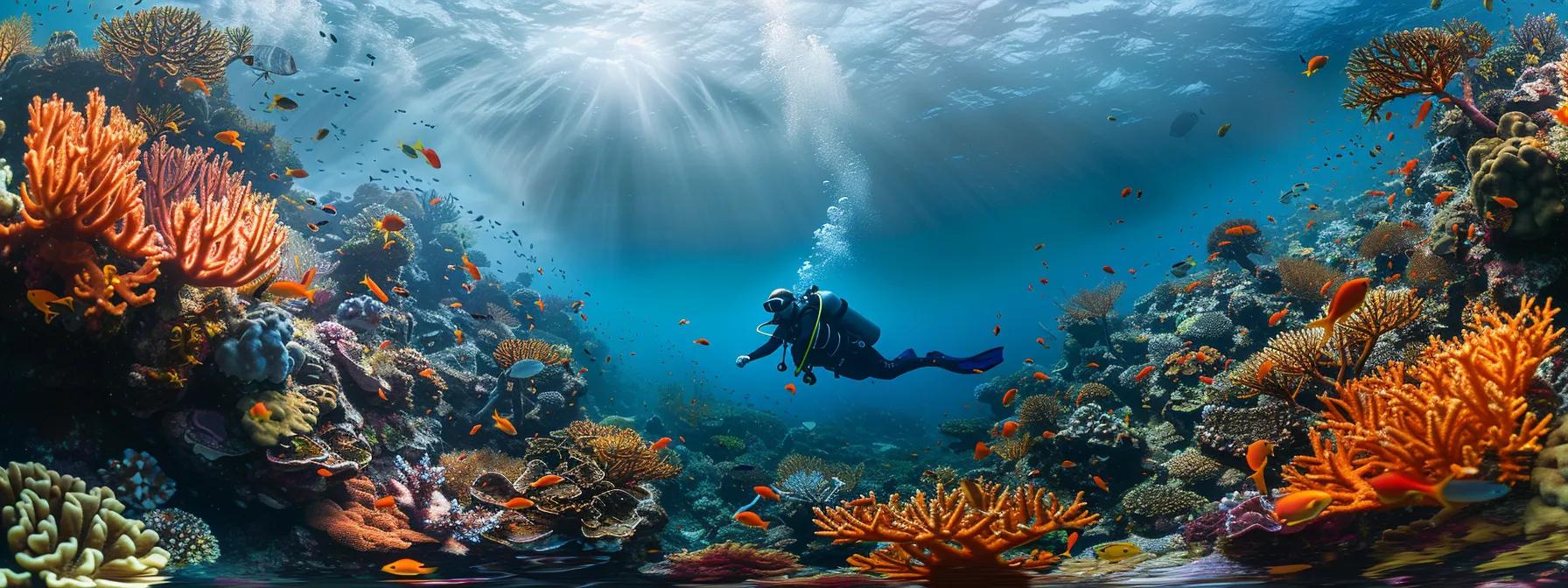
Indonesia offers an unparalleled underwater playground with a wealth of dive sites, vibrant marine biodiversity, and unique cultural experiences. As an adventure diver who has personally explored these tropical waters, I can share that planning a diving trip in Indonesia is both exhilarating and challenging. You’ll immerse yourself in crystal-clear waters, encounter graceful manta rays, stealthy reef sharks, and marvel at the colorful micro life hidden among coral reefs. This guide is a comprehensive resource for anyone interested in scuba diving in Indonesia—whether you are a beginner or an experienced liveaboard diver. We explore top destinations, dive sites, marine life encounters, essential diving techniques, and responsible practices to protect the environment for future generations. Plus, I share important tips on certifications, equipment, optimal timing, and dive packages available through trusted operators. Now, let’s dive into the detailed aspects of scuba diving in Indonesia, beginning with the top destinations for divers.
What Are the Best Scuba Diving Destinations in Indonesia?
Indonesia is renowned for its magnificent dive sites, and the best destination depends on the experience you seek. From the famous Komodo National Park to the enchanting Raja Ampat, each area offers unique underwater adventures. In this section, you will learn about popular areas like Bali—with its variety of dive sites—and explore their individual conditions. Some divers enjoy deep dives in Raja Ampat with peak biodiversity, while others prefer dramatic underwater landscapes in the Gili Islands. Every destination features vibrant coral reefs, diverse species, seasonal water clarity, and currents that shape your dive strategy.
Which Dive Sites Should You Explore in Bali?
Bali is a central hub for divers visiting Indonesia. The island offers dive sites for all levels—from beginner-friendly shallow reefs to challenging sites with deeper walls and strong currents. The Tulamben area is especially popular thanks to the USAT Libertyshipwreck, which attracts barracuda, colorful pipefish, and even occasional whitetip reef sharks. Padangbai also features vibrant coral gardens and cleaning stations where reef fish gather. Whether you seek macro photography of nudibranchs or wide-angle shots of expansive coral formations, Bali offers both excitement and learning opportunities. The less-visited eastern coast reveals hidden gems with dramatic topography and volcanic geological features, boosting dive portfolios and deepening reef conservation knowledge.
What Makes Komodo National Park a Premier Dive Destination?
Komodo National Park is a diver’s paradise known for its crystal-clear waters and the chance to encounter Komodo dragons on land. Underwater, the park boasts a variety of marine life, including schools of pelagic fish, majestic manta rays, and hammerhead sharks. Its vibrant coral reefs support a diverse ecosystem critical to the health of Indonesia’s marine environment. Strong currents create an ever-changing underwater landscape ideal for drift diving. Many divers describe the sight of manta rays gliding effortlessly as a surreal experience that epitomizes Komodo. Liveaboard diving trips are popular here, offering extended underwater time and opportunities to explore remote sites. Designated as a UNESCO World Heritage Site, this marine park sets high standards for conservation and diving safety.
Why Is Raja Ampat Considered a Diving Paradise?
Raja Ampat, off the northwest tip of Papua, is often called the crown jewel of the Coral Triangle due to its unparalleled biodiversity. With more than 1,500 fish species and hundreds of coral species, it offers an incredible variety of underwater life—from lush coral gardens to rugged drop-offs and sponge fields. Divers enjoy exceptional water clarity and nutrient-rich conditions that foster diverse ecosystems. Raja Ampat is ideal for macro photographers hunting pygmy seahorses and for adrenaline-seekers exploring steep walls inhabited by elusive pelagic species. Strong conservation efforts ensure that this natural wonder remains breathtaking for future generations.
What Are the Highlights of Diving in the Gili Islands and Bunaken?
The Gili Islands and Bunaken are celebrated destinations offering distinct underwater experiences. The Gili Islands, near Lombok, set an idyllic scene for drift dives among soft corals, turtles, and schools of tropical fish, attracting divers looking for a relaxed environment. Shallow sites suit beginners and photographers, while experienced divers can explore deeper formations with rich biodiversity. Bunaken, in North Sulawesi, is famous for its vertical walls covered with hard corals and a spectacular array of marine life—including macro critters like frogfish and cuttlefish. Supported by strong local conservation, these sites exemplify Indonesia’s diverse marine ecosystems, water clarity, and overall dive conditions.
What Marine Life Can You Encounter While Scuba Diving in Indonesia?

Diving in Indonesia is an extraordinary opportunity to encounter a dazzling array of marine life. The archipelago, part of the Coral Triangle, boasts high biodiversity that makes each dive session dynamic and educative. In this section, we delve into various species—from gentle giants to tiny critters—and explain what makes each encounter memorable.
How to Spot and Identify Manta Rays During Your Dive?
Spotting manta rays is among the most memorable experiences in Indonesia. These gentle giants glide through the water, often found at cleaning stations where smaller fish remove parasites from their bodies. The best encounters occur during the peak season when updrafts and plankton blooms draw them near dive sites like Komodo National Park and Raja Ampat. Look for their distinct large, triangular pectoral fins and wing-like shape. Use wide-angle cameras and maintain a respectful distance to appreciate both the beauty of these creatures and the health of the ecosystem.
What Shark Species Are Common in Indonesian Waters?
Indonesia hosts various shark species that add thrill to dives. Common species include the blacktip reef shark, whitetip reef shark, and occasional hammerhead and wobbegong sharks. Generally found in shallow, reef-associated areas, these sharks help maintain ecological balance by controlling fish populations. Although their presence might be intimidating, they are key parts of the marine food web. Observing them safely requires calm, respectful behavior and guidance from experienced dive operators.
Which Turtle Species Can Divers See in Indonesia?
Turtles are a cherished component of Indonesia’s marine ecosystem. Divers frequently encounter species such as the green sea turtle, hawksbill, and olive ridley during feeding and nesting. Popular sites like the Gili Islands and Bali offer regular sightings of these graceful creatures. Turtles are generally found in areas with abundant seagrass beds and coral structures that provide necessary shelter and food. Proper diving etiquette helps ensure these ancient mariners remain undisturbed.
Why Are Coral Reefs Vital to Indonesia’s Marine Ecosystem?
Coral reefs are the backbone of Indonesia’s marine ecosystem. They serve as nurseries for many species, protection against erosion, and provide breeding and feeding grounds for marine life—from plankton to large predators like groupers and sharks. Healthy reefs boost fisheries and tourism alike. Unfortunately, they are threatened by climate change and pollution. Understanding their importance underscores the need for responsible diving practices and active involvement in conservation efforts to preserve these vibrant underwater worlds.
How to Experience Whale Shark Sightings Responsibly?
Whale sharks, the gentle giants of the ocean, are highly anticipated by divers. Although infrequent, these gigantic filter-feeders can appear during seasonal aggregations around Indonesia and the Indian Ocean. To observe them responsibly, divers must follow local guidelines, maintain a respectful distance, and avoid rapid movements. Professional guides help ensure that whale sharks are viewed safely and without disturbance, enhancing both the diving experience and broader conservation efforts.
How Do You Prepare and Plan for Scuba Diving in Indonesia?
Proper preparation and planning are crucial in Indonesia given the unique conditions and varied dive sites. This section covers essential steps such as obtaining certifications, understanding seasonal weather and water conditions, and practical advice on budgeting and scheduling. Knowing when the dry season hits certain regions can maximize visibility, while selecting the right dive package or liveaboard option leads to a customized, smooth dive trip.
What Dive Certifications Are Required or Recommended?
Before diving in Indonesia, securing the correct certifications is essential. Most sites require at least an Open Water Diver certification; however, strong currents and deeper sites make an Advanced Open Water Diver certification highly recommended. For specialized dives like drift or night diving, additional courses boost both skills and confidence. These certifications ensure safety, enhance skills, and help divers enjoy a risk-managed experience in challenging underwater environments.
Which Dive Equipment Is Essential for Indonesian Waters?
Diving in Indonesia demands robust, specialized equipment due to diverse conditions. A quality 5mm or 7mm wetsuit helps maintain thermal comfort, especially when diving in deeper or cooler areas. Essential gear includes a reliable BCD, regulator, and dive computer for managing depth and time. Underwater cameras with housings capture the vibrant marine life and seascapes, while dive knives and signaling devices add layers of safety in drift or low-visibility conditions. A well-planned checklist and spare parts can prevent unexpected failures during dives.
When Is the Best Time to Go Scuba Diving in Indonesia?
The optimal time to dive in Indonesia typically falls during the dry season, which varies by region. In areas such as Bali and Komodo National Park, the season usually spans from April to November, offering clear waters and calm conditions. In contrast, Raja Ampat’s best time may differ slightly due to monsoon patterns. Checking local dive center advice and weather forecasts is vital for planning. Understanding seasonal fluctuations not only enhances safety but also increases the likelihood of spectacular underwater photography and marine encounters.
How Much Does Scuba Diving in Indonesia Typically Cost?
Diving costs in Indonesia vary widely based on dive sites, packages, and whether you choose shore dives or liveaboard experiences. On average, a day dive may range from $40 to $80 USD, while multi-day liveaboard trips can start at around $1,000 USD and go above $3,000 USD for luxury options. Additional expenses include certification courses, gear rentals, and optional extras like photography workshops. Many dive centers offer competitive package deals that combine dives with accommodations and meals, making Indonesia an affordable and unforgettable diving destination.
What Are the Available Dive Packages and Liveaboard Options?
Indonesia features diverse dive packages and liveaboard options suitable for various budgets and preferences. Packages may include shore dives, guided sessions, or multi-day tours across key sites. Liveaboard trips, especially in remote regions like Raja Ampat and Komodo, let you explore multiple sites with ease. These packages often bundle accommodations, meals, dive equipment, and guided dives. Custom itineraries allow divers to focus on interests such as macro photography or drift diving, ensuring an experience tailored to both safety and enjoyment.
What Diving Techniques and Skills Are Important for Indonesia’s Dive Sites?

Mastering the right diving techniques is crucial given Indonesia’s challenging underwater terrain. Learn advanced skills in buoyancy control, navigation, and safety procedures to enhance both your experience and photographic results. This section details essential techniques that help divers cope with currents, variable visibility, and complex topography.
How to Master Buoyancy Control for Safe Diving?
Buoyancy control is key to safe, enjoyable diving. Mastering this skill keeps you steady in the water column, reduces contact with delicate marine habitats, and minimizes physical exertion. Practice controlled breathing and fine-tune BCD inflations, using drills like the “hover check” to build muscle memory. Effective buoyancy helps with smooth ascents and descents and protects coral colonies during photography.
What Navigation Skills Are Needed for Indonesian Dive Sites?
Effective underwater navigation is vital in Indonesia’s expansive dive sites. Rely on natural landmarks—coral structures, rock formations, and light shafts—to maintain orientation. In addition to using a compass, understanding current patterns and performing reverse navigation checks increases safety. These skills help you explore lesser-known areas and reduce the risk of disorientation.
How to Practice Safety Procedures While Diving in Indonesia?
Safety procedures are the backbone of any dive plan in challenging Indonesian waters. Regularly practice emergency protocols such as sharing air, controlled emergency ascents, and clear communication through hand signals. A thorough pre-dive briefing on site conditions and hazards is essential. Along with technical readiness, being psychologically prepared can significantly reduce risks and contribute to a sustainable diving environment.
How Can You Improve Underwater Photography Skills?
Indonesia’s underwater landscapes are a treasure trove for photographers. Improving your photography skills involves adjusting camera settings for low-light, capturing both macro and wide-angle shots, and using strobe lighting effectively. Many dive centers offer specialized workshops. Learning the behavior of marine animals and the best times to capture them enhances your portfolio and inspires responsible diving practices.
How Can You Dive Responsibly and Support Marine Conservation in Indonesia?
Responsible diving and marine conservation go hand-in-hand in Indonesia. With increasing numbers of visitors, sustainable practices and cultural respect are essential. This section outlines strategies divers can adopt—from eco-friendly methods to active participation in local conservation programs—to help protect coral reefs and marine life for future generations.
What Are Eco-Friendly Diving Practices to Follow?
Eco-friendly diving practices help preserve Indonesia’s delicate marine ecosystems. Essential practices include maintaining excellent buoyancy to avoid damaging reefs, refraining from touching or collecting marine life, and keeping dive gear properly maintained. Divers can also reduce their carbon footprint by choosing operators committed to environmental conservation and by participating in reef clean-ups and volunteer projects.
How Are Local Conservation Efforts Protecting Coral Reefs and Marine Life?
Local conservation projects play a crucial role in sustaining marine biodiversity. Communities across Indonesia are involved in coral planting, water quality monitoring, and sustainable fishing practices. Many dive centers collaborate with these programs by offering educational tours and conservation-focused dive experiences. These initiatives, supported by both government and NGOs, are vital for keeping protective measures current and effective.
What Is the Role of Divers in Coral Reef Protection?
Divers play a powerful role in protecting coral reefs. By following eco-friendly practices and reporting any damage, divers help preserve sensitive underwater habitats. Many organizations involve divers in reef monitoring and restoration projects, which benefits scientific research and empowers local communities. Sharing experiences and educating peers creates a feedback loop for continuous improvement in reef management.
How Can You Participate in Marine Life Conservation Events?
Marine conservation events offer divers a direct way to contribute. Activities such as coral planting drives, beach cleanups, and educational workshops allow divers to learn about and actively assist in protecting the underwater environment. Local dive clubs frequently organize these initiatives, providing opportunities to connect with experts and gain practical conservation skills—all of which foster long-term sustainability.
What Are Frequently Asked Questions About Scuba Diving in Indonesia?

Below are common questions with practical advice for planning your dive trip to Indonesia.
What Is the Best Time to Go Scuba Diving in Indonesia?
The best time to dive depends on the region. In Bali and Komodo National Park, the dry season from April to November offers clear waters and calmer conditions. In Raja Ampat, seasonal variations due to monsoon patterns require checking local recommendations. Planning during peak seasons improves visibility and increases marine life encounters.
Where Are the Best Dive Sites in Bali and Other Regions?
Bali’s top dive sites include Tulamben with its iconic shipwreck and Padangbai’s vibrant coral gardens. For advanced dives, Komodo National Park and Raja Ampat are preferred due to strong currents and high biodiversity. Bunaken also offers dramatic sites with vertical walls and rich macro life. Choosing a site depends on your certification, personal preference, and current dive conditions.
What Certifications Do I Need to Dive in Indonesia?
Most dive sites require a minimum of an Open Water Diver certification, though more challenging sites recommend an Advanced Open Water Diver certification. For technical dives, specialty certifications like Deep Diver or Drift Diver may be needed. Ensure your certification is recognized by local dive centers such as those affiliated with PADI, SSI, or NAUI.
How Much Does It Cost to Go Scuba Diving in Indonesia?
Diving costs vary by location and type of dive. A day dive generally costs $40 to $80 USD, while multi-day liveaboard trips can range from $1,000 to over $3,000 USD. Additional expenses may include certification, gear rentals, and photography workshops. Many dive centers offer package deals that combine dives with accommodations and meals.
What Marine Life Can I Expect to See While Diving?
Indonesia is a marine biodiversity hotspot. Expect to see tropical fish, coral reefs, manta rays, whale sharks, and various reef sharks, along with turtles, barracuda, and macro invertebrates like nudibranchs and pipefish. Many sites feature cleaning stations where fish and cleaner shrimp interact, offering unique photographic moments.
How to Book Your Scuba Diving Adventure With IndoDive Adventures?
Booking with a reputable provider like IndoDive Adventures ensures a well-organized and unforgettable trip. Whether you choose liveaboard or shore dives, IndoDive offers tailor-made packages, expert local guides, and a seamless booking experience with high safety standards.
What Customized Dive Packages Does IndoDive Adventures Offer?
IndoDive Adventures caters to both beginners and experienced divers with packages ranging from individual day dives to multi-day liveaboard trips. Options can be customized to focus on interests such as macro photography, drift diving, or deep dives in areas like Komodo or Raja Ampat. Transparent pricing and detailed itineraries help maximize the underwater experience while ensuring safety.
How Do Expert Local Guides Enhance Your Diving Experience?
Expert local guides at IndoDive Adventures bring in-depth knowledge of Indonesia’s marine ecosystems and emphasize conservation. They safely navigate challenging conditions, share insights on local marine biology, and assist with underwater photography—often guiding you to hidden spots to enhance your overall adventure.
What Accommodation and Liveaboard Options Are Available?
IndoDive Adventures provides various accommodation options, from comfortable on-shore hotels to luxurious liveaboards. Liveaboard trips are popular for traveling between diverse dive sites while enjoying onboard amenities like gourmet meals and comfortable quarters. These options allow you to relax, plan additional dives, and share experiences with fellow divers.
How to Contact IndoDive Adventures for Booking and Inquiries?
Contacting IndoDive Adventures is easy via phone, email, or an online booking system found on their website. Detailed information on dive packages, itineraries, and FAQs is available to help you plan your trip efficiently, ensuring a memorable and hassle-free adventure.
Frequently Asked Questions
Q: What is the best time to dive in Indonesia? A: The optimal time is generally during the dry season—from April to November in Bali and Komodo National Park—when water conditions are clear and calm. However, check local recommendations for areas like Raja Ampat due to monsoon variations.
Q: Are there any specific certifications required for diving in Indonesia? A: An Open Water Diver certification is the minimum requirement, but advanced or specialty certifications (e.g., Advanced Open Water, Deep Diver) are highly recommended for more challenging sites.
Q: What types of marine lifecan I expect to see while diving in Indonesia? A: Expect vibrant coral reefs, tropical fish, manta rays, whale sharks, and reef sharks, along with turtles, barracuda, and macro critters like nudibranchs and pipefish. Cleaning stations offer unique interactions among marine species.
Q: How much does it typically cost to dive in Indonesia? A: Diving costs range from $40 to $80 USD per day, with liveaboard trips starting at about $1,000 USD and going higher for luxury experiences. Additional fees may apply for certifications and gear rentals.
Q: What should I pack for a diving trip in Indonesia? A: Essential gear includes a dive computer, quality wetsuit, fins, mask, and snorkel. Bring an underwater camera, spare batteries, a dive log, and reef-safe sunscreen. Verify with your operator for any additional requirements.
Q: How do I support local conservation through diving? A: Support conservation by practicing proper buoyancy control, refraining from touching marine life, and joining coral restoration projects or clean-up initiatives organized by dive operators.
Q: Can I combine diving with other activities in Indonesia? A: Absolutely. Many divers complement their underwater adventures with cultural tours, hiking, or exploring volcanic landscapes, taking advantage of Indonesia’s rich heritage and natural beauty.
Final Thoughts
Indonesia’s underwater world is a spectacular realm of adventure waiting to be explored. From the renowned dive sites of Bali and Komodo National Park to the unparalleled biodiversity of Raja Ampat, every dive offers a new discovery. By properly preparing—obtaining the right certifications, choosing the optimal season, and practicing eco-friendly diving—you ensure both a safer experience and contribute to preserving these extraordinary ecosystems. Whether you choose a liveaboard adventure or shore dives with IndoDive Adventures, every dive is an opportunity to connect with nature and protect it for the future.


